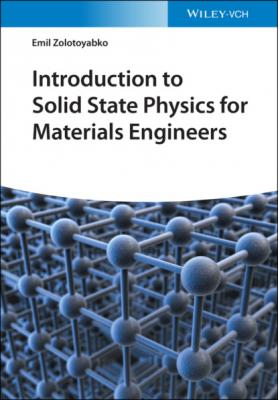ТОП просматриваемых книг сайта:
Introduction to Solid State Physics for Materials Engineers. Emil Zolotoyabko
Читать онлайн.Название Introduction to Solid State Physics for Materials Engineers
Год выпуска 0
isbn 9783527831593
Автор произведения Emil Zolotoyabko
Жанр Физика
Издательство John Wiley & Sons Limited
17 11 Cooperative Phenomena in Electron Systems: Ferromagnetism 11.1 Paramagnetism and Ferromagnetism 11.2 The Ising Model 11.3 Magnetic Structures 11.4 Magnetic Domains 11.5 Magnetic Materials 11.6 Giant Magnetoresistance 11.A The Elementary Magnetic Moment of an Electron Produced by its Orbital Movement 11.B Pauli Paramagnetism 11.C Magnetic Domain Walls
18 12 Ferroelectricity as a Cooperative Phenomenon 12.1 The Theory of Ferroelectric Phase Transition 12.2 Ferroelectric Domains 12.3 The Piezoelectric Effect and Its Application in Ferroelectric Devices 12.4 Other Application Fields of Ferroelectrics
19 13 Other Examples of Cooperative Phenomena in Electron Systems 13.1 The Mott Metal–Insulator Transition 13.2 Classical and Quantum Hall Effects 13.3 Topological Insulators 13.A Electron Energies and Orbit Radii in the Simplified Bohr Model of a Hydrogen-like Atom
21 List of Prominent Scientists Mentioned in the Book
22 Index
List of Tables
1 Chapter 1Table 1.1 Summary of possible symmetries in regular crystals.Table 1.2 Possible types of rotation axes permitted by translational symmetry...
2 Chapter 4Table 4.1 Specific electrical resistivity of selected metals.Table 4.2 Defects' contribution to electrical resistivity of Al.
3 Chapter 5Table 5.1 Fermi energies for selected metals.Table 5.2 Thermal conductivity in the selected metals.
4 Chapter 6Table 6.1 Bandgaps in the selected semiconductors.
5 Chapter 7Table 7.1 The values of work function in selected metals.
6 Chapter 10Table 10.1 Critical temperatures (Tc in Kelvins) and critical magnetic fields...
7 Chapter 11Table 11.1 Magnetic characteristics of the selected permanent magnets.
8 Chapter 12Table 12.1 Piezoelectric modulidik (in pC/N) for selected materials.Table 12.2 Band gaps for selected ferroelectrics.
List of Illustrations
1 Chapter 1Figure 1.1 High-resolution scanning transmission electron microscopy image o...Figure 1.2 Structural motifs in silicon dioxide (SiO2): (a) – ordered atomic...Figure 1.3 Dense filling of 2D space by spatially ordered, though non-period...Figure 1.4 Dense filling of 2D space by regular geometrical figures.Figure 1.5 Dodecahedron sculpted by 12 pentagonal faces.Figure 1.6 Icosahedron sculpted by 20 triangular faces.Figure 1.7 Regular pentagon with edges equal ap and diagonals equal dp. The ...Figure 1.8 Unit cells of the following side-centered Bravais lattices: A-typ...Figure 1.9 Unit cells of the following centered Bravais lattices: (a) face-c...Figure 1.10 Lattice translations (red arrows) in the rhombohedral setting of...Figure 1.11 The presence of inversion center (C) in diamond structure (a) an...Figure 1.12 Illustration of the Biot–Savart law (Eq. (1.7)).Figure 1.13 Illustration of the wave scattering in a periodic medium.Figure 1.14 Sketch of a crystal plane, normal to the vector of reciprocal la...Figure 1.15 Graphical interrelation between wavevectors of the incident (ki)...Figure 1.16 The traces of isoenergetic surfaces (red curves) in reciprocal s...Figure 1.17 Illustration of the restrictions imposed by translational symmet...Figure 1.18 Illustration of the simultaneous appearance of several high-orde...Figure

